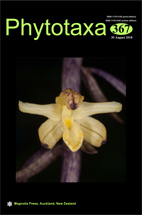Abstract
Two new species of the genus Amanita are described from India. Amanita argenteoalba, a member of subgenus Lepidella section Lepidella, is characterized by its small to medium sized basidiocarps, white to silvery white pileus with brownish orange tinge, universal veil on pileus as floccose-felted to subfelted patches, rooting bulb covered by recurved scales on its upper parts, subglobose basidiospores, the absence of clamp connections in the basidioma and universal veil on pileus comprising of irregularly arranged inflated cells with scattered to frequent filamentous hyphae and occurrence in broad leaf forest under Rhododendron arboreum. Amanita dhakuriana, a representative member of subgenus Amanita section Vaginatae, is characterized by its small sized basidiocarps, the pileus that is greenish grey over centre and pale grey towards the margin and subglobose to broadly ellipsoid basidiospores. Both species are described, illustrated and compared with morphologically similar taxa, and nrLSU-based phylogenetic analyses were provided.

